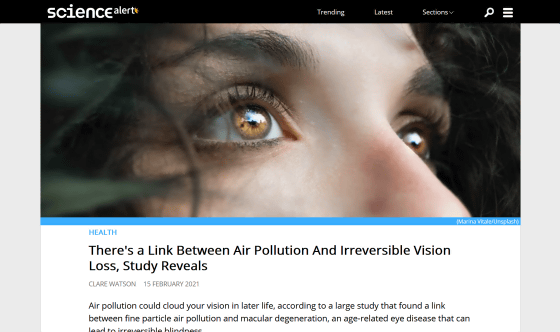Research results suggest that air pollution is associated with diseases that lead to blindness

It is known that air pollution leads to various health problems, and it has been
Association of ambient air pollution with age-related macular degeneration and retinal thickness in UK Biobank | British Journal of Ophthalmology
https://bjo.bmj.com/content/early/2021/01/11/bjophthalmol-2020-316218
There's a Link Between Air Pollution And Irreversible Vision Loss, Study Reveals
https://www.sciencealert.com/air-pollution-linked-to-deteriorating-vision-in-older-age-study-finds

Air pollution is a problem that affects people around the world, and the World Health Organization (WHO) points out that 'about 91% of people in the world live in places where air pollution levels exceed WHO standards.' .. The death toll from stroke, heart disease, lung cancer, and chronic respiratory illness due to air pollution is said to reach 4.2 million annually, and the exhaust gas from factories containing soot and pollutants scattered by forest fires is a public health concern. Is bringing.
In addition, PM2.5, a particulate matter with a diameter of 2.5 micrometers or less, that floats in the atmosphere is particularly dangerous. PM2.5 is so small that it easily penetrates deep into the lungs, increasing the risk of respiratory and circulatory disorders such as asthma and bronchitis, and can irritate the eyes and throat and cause dyspnea. There is also sex.
Therefore, a research team of researchers from the United Kingdom and the United States conducted research focusing on air pollution and the risk of age-related macular degeneration. Age-related macular degeneration is a disease in which waste products such as fat and protein accumulate in the macula tissue located in the center of the retina, and new blood vessels form and bleed, making it difficult to see. As symptoms progress with age, vision deteriorates and, in the worst case, can lead to blindness.

It is known that age-related macular degeneration is increased by inheritance and smoking habits, but the research team thought that air pollution might be related to the risk of age-related macular degeneration. We conducted an analysis using data from
The data used in the analysis included information from 116,000 people who answered whether they had been diagnosed with age-related macular degeneration since 2006, of which 52,062 actually had vision or retina. He said he was measuring thickness and eye health. In addition, the research team used publicly available datasets to estimate the level of air pollution near the addresses these subjects responded to in the questionnaire.
Comparing data on age-related macular degeneration with air pollution levels near home, subjects who lived in areas with higher PM2.5 scattering were more likely to develop age-related macular degeneration. Turned out. In addition, subjects who were exposed to the atmosphere with low PM2.5 but high nitrogen dioxide also showed signs of age-related macular degeneration in the thickness of the retina.

It should be noted that this data only reveals a correlation, and the causal relationship that 'air pollution causes age-related macular degeneration' has not been identified. Researchers suggest that air pollution may increase inflammatory levels and oxidative stress in the body, resulting in adverse effects on the eyes, but further research is needed to accurately investigate the effects. That is.
Related Posts:
in Science, Posted by log1h_ik







